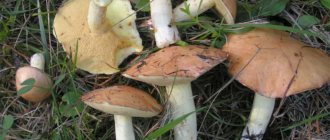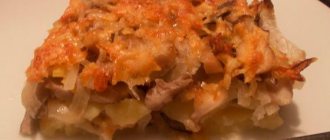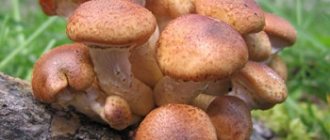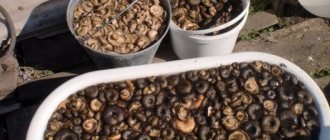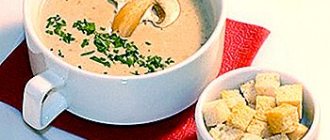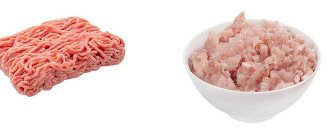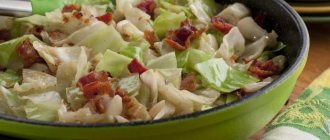Content of minerals in mushrooms: (per 100 grams of product)
| Mushrooms | Potassium | Calcium | Magnesium | Phosphorus | Sodium | Iron |
| Oyster mushroom | 420 mg | 3 mg | 18 mg | 120 mg | 18 mg | 1.3 mcg |
| Camelina mushroom | 310 mg | 6 mg | 8 mg | 41 mg | 6 mg | 2.7 mcg |
| Morel mushroom | 411 mg | 43 mg | 19 mg | 194 mg | 21 mg | 12.2 mcg |
| Porcini mushrooms | 468 mg | 13 mg | 15 mg | 89 mg | 6 mg | 0.5 mcg |
| Dried white mushrooms | 3937 mg | 107 mg | 102 mg | 606 mg | 41 mg | 4.1 mcg |
| Chanterelles | 450 mg | 4 mg | 7 mg | 44 mg | 3 mg | 0.7 mcg |
| Honey mushrooms | 400 mg | 5 mg | 20 mg | 45 mg | 5 mg | 0.8 mcg |
| Boletus mushrooms | 443 mg | 6 mg | 15 mg | 171 mg | 3 mg | 0.3 mcg |
| Boletus mushrooms | 404 mg | 3 mg | 16 mg | 70 mg | 6 mg | 0.3 mcg |
| Russula mushrooms | 269 mg | 4 mg | 11 mg | 40 mg | 4 mg | 0.6 mcg |
| Champignon mushrooms | 530 mg | 4 mg | 15 mg | 115 mg | 6 mg | 0.3 mcg |
| Shiitake mushrooms | 304 mg | 2 mg | 20 mg | 112 mg | 9 mg | 0.4 mcg |
| Mushrooms fried in vegetable oil | 1044 mg | 40 mg | 44 mg | 241 mg | 470 mg | 1.7 mcg |
| Fried mushrooms with potatoes | 519 mg | 19 mg | 22 mg | 84 mg | 194 mg | 0.9 mcg |
| Baked mushrooms | 634 mg | 72 mg | 28 mg | 137 mg | 445 mg | 1 mcg |
| Solyanka mushroom | 97 mg | 9 mg | 4 mg | 18 mg | 235 mg | 0.6 mcg |
| Stewed mushrooms with potatoes | 515 mg | 25 mg | 13 mg | 95 mg | 223 mg | 0.9 mcg |
Discussion on the forum (comments: )
Article added: 2017-01-16
| What vegetables are the healthiest? What vegetable is the healthiest for humans? Comparative analysis of vegetablesWhich flour is healthier?Which flour is the healthiest, and which flour is better to use for baking?Food calorie tableCalorie content of food per 100 grams (table)Vitamins in food (table)Table of vitamin content in foodBasic metabolism (calorie consumption per day) Basic (daily) calorie consumption calculator for men and women, online |
Benefits of boletus
Porcini mushroom, the benefits of which are almost limitless, stimulates digestion and improves the functioning of gastric juices. To do this, you need to eat boletus broth, which is considered more useful than regular meat broth.
Thanks to the vitamins contained in mushrooms, they are very useful for the functioning of the thyroid gland. They have a beneficial effect on the beauty and health of skin, hair, and nails.
Also important properties of porcini mushroom include tonic, wound healing, antibacterial and antitumor effects. For example, sulfur and polysaccharides will help in the fight against cancer.
Porcini mushroom, the benefits of which are known to everyone, contains lecithin as a beneficial component, which helps prevent the accumulation of cholesterol on the walls of blood vessels. And this is very important for the prevention of atherosclerosis. In turn, amino acids act as assistants in the process of cell renewal, helping to activate the corresponding processes.
Boletus contains a lot of antioxidants, which are also very useful. It prevents viruses, bacteria and other harmful substances from entering the body.
Porcini mushroom, oddly enough, is used in medicine. Doctors note its particular effectiveness for tuberculosis, exhaustion of the body, and reduced metabolism. But the special aqueous extract it contains helps in solving problems associated with ulcers and frostbite.
Dried porcini mushroom acts as a source of protein, which is absorbed by the body by 80%. It also contains enzymes that help break down fats and glycogen. Dried porcini mushrooms can be used to prevent cancer, headaches, as well as for inflammatory processes and anemia. They strengthen the heart and body in general, and stimulate mental abilities.
Chemical composition
Mushrooms contain substances that have an extremely positive effect on the human body. But an approximate table of product composition:
| Components | Approximate amount for every 100 grams |
| Vitamins |
|
| Microelements |
|
| Macronutrients |
|
| Fatty acid | Omega 6 - about 0.5 g |
| Cellulose | From 2.5 to 4 g |
| Saturated fatty acids |
|
| Monounsaturated fatty acids | Omega 9 - about 0.030 g |
| Polyunsaturated fatty acids | Linoleic acid – not less than 0.5 g |
| Sahara | No more than 0.1 g |
| Ash | No more than 1 g |
| Water | 90 to 92% |
The high nutritional value of the product is represented by the ratio of proteins, fats and carbohydrates (BJU), which is 4.5/1/0.2 g per 100 grams. The energy value largely depends on the type of mushroom and ranges from 25-40 kcal for every 100 grams.
Calorie content also depends on the method of preparation of the product:
| Cooking method | Approximate number of calories |
| Pickled | Within 40-45 kcal |
| Dried | From 120 to 200 kcal depending on the type |
| Salty | No more than 30 kcal |
| Boiled | Within 50 kcal with minor deviations |
| Stewed | From 70 to 150 kcal depending on additional ingredients |
| Fried | From 75 to 180 kcal |
Calorie content and nutritional value of mushrooms
Pickled mushrooms are food products with an average calorie content of 22 kcal. Chanterelles, milk mushrooms and boletus are considered dietary - 18 kcal. The maximum energy value is contained in pickled porcini mushrooms and champignons - 37 kcal.
Despite the low calorie content of this product, mushrooms cannot be classified as dietary products. Most of its nutritional value is protein (2.3 grams), which is characterized by fairly slow digestion. As for the amount of fat in their composition, it is minimal (0.8 grams). Well, due to the fact that the marinade contains sugar and spices, they contain 1.9 grams of carbohydrates.
Rules of use
The product is allowed to be used no more than 2 times a week. The amount is determined individually and depends on the person’s health status and possible complications after administration. For an adult, 100-150 g at a time is enough. During pregnancy and lactation, it is worth limiting this amount to 50 g per dose.
Children over 5 years old are allowed no more than 1 piece and no more than 2 times a week. Those who suffer from chronic digestive disorders should carefully monitor their condition when consuming the product and limit themselves to 40-50 g. Frequent use will certainly cause complications.
Boiled, stewed and dried mushrooms in moderate quantities will be the most useful. Salted, fried and pickled foods are best consumed rarely and in small portions. Currently, artificially cultivated mushrooms will become safer and healthier, especially for residents of large cities with a large number of industrial enterprises located nearby.
The use of porcini mushrooms in medicine
Due to the huge number of beneficial properties, porcini mushrooms are common not only in cooking, but also in alternative medicine. Riboflavin in their composition helps to cope with diseases of the thyroid system. The complex of vitamins has a beneficial effect on the condition of nails, hair and skin. Lecithin, which is part of the product, ensures the prevention of atherosclerosis and anemia. It is able to break down cholesterol plaques formed in blood vessels.
We recommend reading: Pumpkin flour: benefits and harms
The use of porcini mushroom tincture is important for thrombophlebitis and varicose veins. It can be taken orally and used locally. Rubbing the lower extremities has a beneficial effect on blood circulation and eliminates discomfort.
Before use, it is important to thoroughly clean the fruiting bodies of dirt and debris.
For impotence and uterine fibroids, the drug is taken orally. Frequency – twice a day, 1 tbsp. l., after diluting the tincture with a small amount of warm water. For cardiovascular diseases, a single dosage is 1 tsp.
A decoction of porcini mushrooms can be used for hypertension and cholecystitis. It is taken 120 ml 1-2 times a day. In terms of nutritional value, it is in no way inferior to chicken broth. It is often used to speed up recovery processes after suffering serious illnesses.
Porcini mushrooms are also used against cancer as an addition to the main therapy. They have a general strengthening effect and remove toxic substances from the body. The desired effect is achieved due to the content of beta-glucan.
And a little about secrets...
The story of one of our readers Alina R.:
I was especially depressed about my weight. I gained a lot, after pregnancy I weighed as much as 3 sumo wrestlers together, namely 92 kg with a height of 165. I thought the belly would go away after giving birth, but no, on the contrary, I began to gain weight. How to cope with hormonal changes and obesity? But nothing disfigures or makes a person look younger than his figure. At the age of 20, I first learned that plump girls are called “WOMAN”, and that “they don’t make clothes that size.” Then at the age of 29, divorce from her husband and depression...
But what can you do to lose weight? Laser liposuction surgery? I found out - no less than 5 thousand dollars. Hardware procedures - LPG massage, cavitation, RF lifting, myostimulation? A little more affordable - the course costs from 80 thousand rubles with a nutritionist consultant. You can, of course, try to run on a treadmill until you go crazy.
And when will you find time for all this? And it's still very expensive. Especially now. Therefore, I chose a different method for myself...
Read more >>
Mushrooms and vitamins
Mushrooms contain many important vitamins such as vitamin B, C and D. Vitamin B is good for healthy skin and helps prevent heart disease. In addition, vitamins B2 and B3 contribute to the maintenance of red blood cells and healthy nervous system function. Vitamin D, associated with ensuring strong teeth and bones, which turns out to be much more for our body: it is important for cell division and strengthening the immune system. Mushrooms are the only source of vitamins of non-animal origin, which is unique and very helpful for vegetarians! Mushrooms contain vitamin D, and it is enhanced when mushrooms are exposed to sunlight. In the example given, the table shows the nutritional value of mushrooms, namely porcini mushroom.
Common types
According to scientists, there are more than 100 thousand species of mushrooms in nature. But not all varieties are eaten. There are several species that are common in Russia and are cultivated artificially.
White
Porcini mushroom, or boletus, is considered the most valuable type of mushroom because it has unique taste and beneficial properties. The species is quite large, has juicy flesh and grows up to 15 cm in length with a cap diameter of 20 cm. It grows under birch, oak, and pine trees.
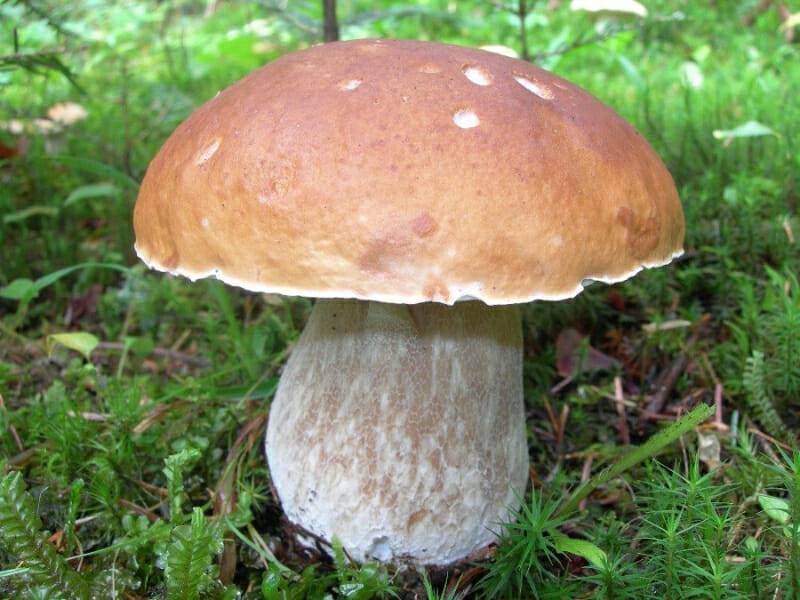
A distinctive feature of this species will be the white flesh, which does not change when cut and emits a pleasant smell. You can distinguish boletus mushrooms from other similar mushrooms by the skin on the cap, which cannot be removed. The variety is ideal for stewing, frying, drying or pickling.
Chanterelles
Chanterelles are easy to distinguish from other species by their unique cap shape and orange color. Another feature will be the mucous surface, dense body and leg. Chanterelles grow up to 4 cm in height with a cap diameter of up to 5 cm. They are most often found in grassy areas with good access to sunlight. Chanterelles do not grow in the forest.
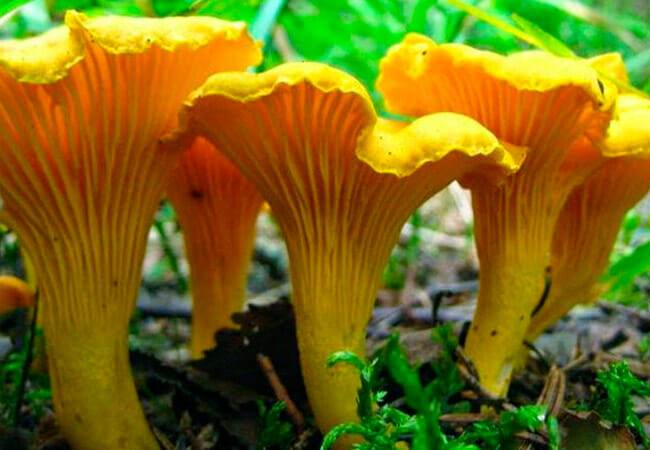
In cooking, a similar variety is used boiled, stewed, fried, pickled and salted.
Oyster mushrooms
A fairly common variety, growing in groups on the trunks of weakened or almost dried out trees. You can find them on birch, oak, pine, and rowan trees. With a stalk that reaches a maximum length of 5 cm, the mushroom has a cap up to 30 cm in diameter. The pulp is juicy, white or yellowish.

As the flesh ages, it loses its elasticity and juiciness. For this reason, only young oyster mushrooms are eaten. This species is suitable for various processing methods and is actively cultivated in many countries.
Honey mushrooms
Honey mushrooms are distributed everywhere and prefer to grow close to tree trunks or directly on them. Often found on dead trunks or stumps. They are small in size, the cap rarely reaches a diameter of more than 10 cm, and the leg grows no more than 8 cm. They resemble chanterelles in color.
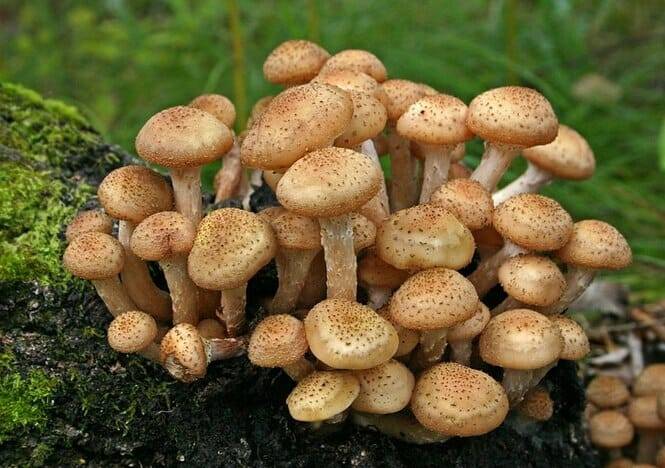
Honey mushrooms are actively used in cooking for cooking, drying, stewing, pickling, and pickling. They have juicy pulp.
Champignon
Champignons are a popular type of mushroom, since they are not only actively collected by mushroom pickers, but also cultivated under artificial conditions. They have a dense stem no more than 5 cm long, a cap that reaches 20 cm in diameter. The flesh is white when cut, but darkens after a few minutes in the open air.
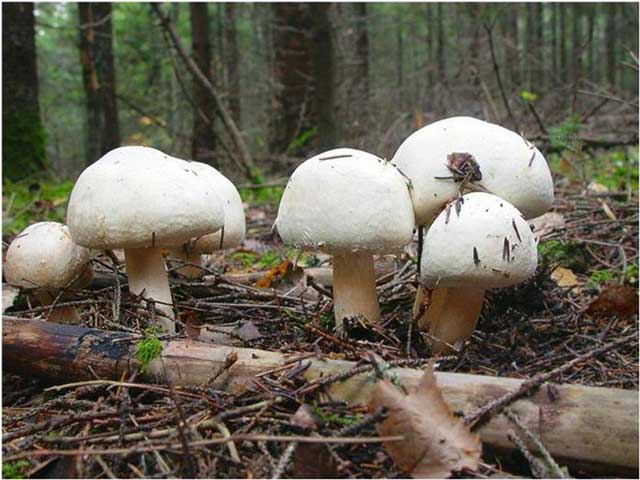
The mushroom exudes a pleasant aroma and tastes very juicy. Under natural conditions it grows in forests and open grassy areas. Suitable for any processing method and less likely than other types to cause indigestion, allergies, and other unpleasant symptoms.
Properties of pickled mushrooms
Nutritional value and composition | Vitamins | Minerals
How much does pickled mushrooms cost (average price for 1 kg)?
Moscow and Moscow region.
500 rub.
Mushrooms occupy one of the most important places in the daily diet of both the inhabitants of our latitudes and the population of the planet earth as a whole. From a scientific point of view, mushrooms are understood as a vast kingdom of living nature, which includes a colossal number of species. It is noteworthy that mushrooms can be found in all biological niches known to modern science.
That is why it is quite difficult to overestimate the importance of the mushroom kingdom of human civilization. People have been using just a huge number of different types of mushrooms in the process of making food products for a long time. In addition, some types of mushrooms are considered a valuable natural material, which is actively used in the pharmacological industry, as well as in medicine.
As noted earlier, mushrooms have found quite wide application in cooking. Typically, mushrooms are boiled or fried, as well as dried and frozen. Canned and pickled mushrooms have always been especially popular. Numerous varieties of mushrooms are used to make a fairly large number of culinary products.
Mushrooms are included in the recipes of soups, many sauces, as well as main dishes or appetizers. Mushrooms can be used to make a delicious and nutritious filling for baked goods. Pickled mushrooms can be added to the list of the most popular food products and snacks that are in demand among domestic consumers.
Various types of pickled mushrooms can be easily found on the shelves of the vast majority of domestic grocery stores. However, even in our time, most mushroom pickers try to make pickled mushrooms at home.
After all, the store-bought version cannot compare in taste and quality with home-cooked pickled mushrooms. In order to prepare tasty, and most importantly healthy, pickled mushrooms, do not neglect some recommendations in the process of preparing the product.
For example, it is best to prepare pickled mushrooms when they are young and strong in structure, and in addition, they must not be wormy or damaged. Among the main types of pickled mushrooms most often found in our latitudes, the following types can be distinguished: pickled porcini mushrooms, saffron milk caps, boletuses, chanterelles, butter mushrooms, as well as honey mushrooms, aspen mushrooms, boletus mushrooms, boletus mushrooms and others.
Beneficial features
A large amount of protein makes the product no less healthy than poultry meat. The benefits of mushrooms are as follows:
- have antibacterial, anti-inflammatory and mild diuretic properties;
- normalize metabolic processes and promote slow, safe weight loss;
- stimulate tissue regeneration processes;
- relieve headaches, eliminate tinnitus;
- strengthen the vascular wall and reduce capillary permeability;
- prevent the deposition of cholesterol plaques and the development of atherosclerosis;
- improve myocardial functioning and prevent heart failure;
- normalize blood pressure numbers, prevent its sharp jumps;
- stimulate the production of digestive enzymes and bile;
- prevent stagnation in the gallbladder and the formation of cholesterol stones;
- strengthen bones and teeth;
- improve psycho-emotional state, prevent stress, depression, insomnia;
- improve memory and concentration;
- promote the removal of harmful compounds from the body;
- have a beneficial effect on joints with arthritis and arthrosis, relieve acute symptoms of pathology;
- relieve fatigue after prolonged exercise;
- help improve and maintain visual function;
- strengthen the immune system and prevent frequent viral and cold pathologies;
- replenish the deficiency of minerals and vitamins;
- slow down the growth and development of atypical cancer cells.
The product is useful for men because it prevents pathologies of the urinary system, stimulates sexual function and prevents its early decline, increases endurance and physical strength, and promotes muscle growth during intense sports.
For women, mushrooms are valuable because they normalize hormonal levels, the menstrual cycle, relieve unpleasant symptoms during menopause, help strengthen nails and strands and help maintain healthy skin. The antioxidant properties of the product help slow down the aging process and prevent the loss of elasticity of the epidermis.
Benefits of dried porcini mushrooms
To preserve the benefits of the product for a long time, they are dried. Such preparations will allow you to enjoy your favorite dish at any time. The amount of useful substances during the drying process decreases slightly. The characteristic aroma and rich mushroom taste are also preserved.
The benefits of dried porcini mushrooms are as follows:
- assistance in the breakdown of fats;
- antitumor effect;
- strengthening the immune system;
- analgesic effect;
- hepatoprotective effect.
Dried mushroom pulp is considered a fairly good alternative to fresh. The protein in its composition is much better absorbed by the digestive system. If a person has diseases of the gastrointestinal tract, this option is most preferable.
Important! Dried mushrooms, crushed, can be used as a seasoning.
Contraindications and possible harm
In some cases, the product may be harmful to health. Main contraindications:
- severe form of gastritis with low acidity of gastric juice;
- peptic ulcer in the acute stage with the threat of perforation of the stomach wall;
- chronic or acute pancreatitis with severe pain;
- acute stage of gout;
- individual intolerance;
- end stage renal failure;
- enteritis and colitis in the acute stage;
- severe form of liver cirrhosis and liver failure;
- indigestion;
- elderly age;
- persistent constipation.
Pregnancy and breastfeeding are not considered a contraindication, but the product should only be used in doses and with the permission of the attending physician. Children under 5 years old should not be given mushrooms in any form, since the child’s body does not produce the special enzymes that are necessary to digest them.
If the recommendations are not followed, a person often develops side effects in the form of pain and heaviness in the stomach, spasms of intestinal smooth muscles, constipation, nausea, vomiting, and headache. Such a reaction can be the result of overeating or poisoning with a low-quality product or a violation of cooking technology.
Harm of porcini mushroom and contraindications
Before you diversify your diet, you need to become familiar with not only the health benefits, but also the harms of porcini mushrooms. Unpleasant symptoms can occur if the heat treatment of the product is neglected. Specimens collected near industrial facilities and highways can also cause harm. Especially if they have absorbed mercury, lead and harmful fumes for a long time. Possible adverse reactions include the following:
- stomach ache;
- urge to vomit;
- stool disorder;
- dizziness;
- allergic reaction.
Since mushrooms are a fairly heavy product, not everyone is allowed to eat them. Contraindications include:
- disruption of the gastrointestinal tract;
- individual intolerance;
- age under 5 years;
- the first months of breastfeeding.
Attention! If an allergic reaction occurs, you should take an antihistamine.
